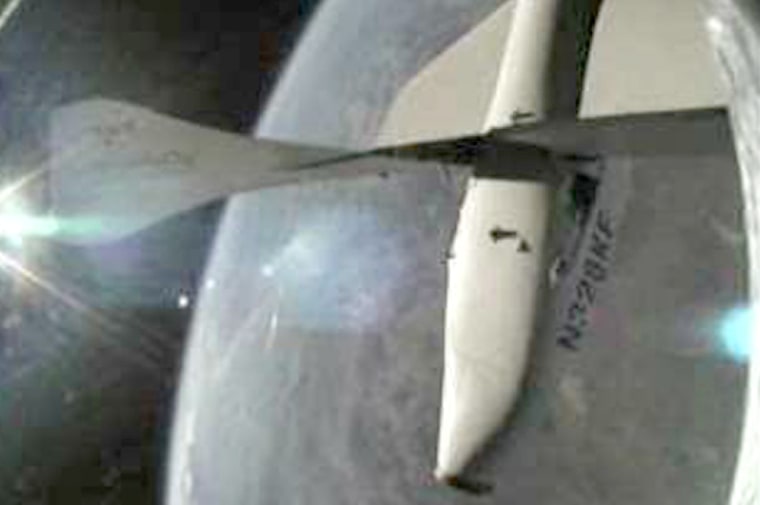In the crisp early morning of June 21, the privately developed rocket plane SpaceShipOne shot itself to the edge of space. Starting from 50,000 feet, the craft took slightly more than a minute to breach the final frontier, 62 miles (100 kilometers) above the saffron sands of California’s Mojave Desert.
Space, according to the rules of this game, begins 100 kilometers up. That’s obviously an arbitrary definition.
True, there’s not much air at that altitude — indeed, wings become useless. But then again, if you figure that getting into space somehow implies escaping Earth’s maternal grasp, then 100 kilometers isn’t particularly spacey. Even the moon, which is 4,000 times farther than this nominal frontier, is obviously a slave to our planet. It is part of Earth (and, given the circumstances of its birth, is also part Earth).
And then there’s the matter of which space you’re talking about. In the movies, one always refers to "outer space." This implies, somehow, that there’s also an "inner space" and maybe a "midspace."
Leaving aside these ambiguous refinements, I think it would be reasonable to claim that real space begins where Earth’s gravity is no longer dominant: maybe halfway to the next planet, which means that the "Now Entering Space" sign should be posted about 13 million miles (21 million kilometers) above your hometown.
Virgin territory for humans
By this definition, humans have never made it into space, although some of our robotic hardware has. But that’s my interpretation, and the facts are that, according to international law, there’s no defined point where the atmosphere ends or where space begins.
Irrespective of what you think about the final frontier’s exact location, crossing it requires speed. As all rocket jockeys realize, leaving our planet necessitates getting your bod or pod up to escape velocity in order to haul it out of Earth’s very steep gravity well.
But reaching escape velocity is not trivial. The requisite speed is 7 miles per second (11.2 kilometers per second), or 25,000 miles an hour.
If you are content to merely reach low Earth orbit, as the shuttle astronauts are, then the speed requirement is more modest: only 5 miles (8 kilometers) per second. For SpaceShipOne, which ascended to 62 miles (100 kilometers) and then came right back down, the necessary velocity was 1 mile (1.6 kilometers) per second. In other words, per pound of payload, SpaceShipOne’s energy requirement was only 4 percent of the space shuttle, and only 2 percent of that necessary to take a pilot to the moon or beyond.
This isn’t to denigrate SpaceShipOne’s achievement. On the contrary, the flight was highly significant. It was, after all, a private venture, and the craft was designed and built for a small fraction of the cost of a single shuttle launch.
Million-dollar airplane flights?
For years, nozzle nerds have been saying that the only way to make space truly accessible is to encourage private rocketry. These folks point to the history of aviation, and are fond of opining that if airplane development had been left to a government agency, the cost of a contemporary flight from L.A. to New York would be a few million dollars, and the time necessary to refuel and refit the plane at the airport would be months.
That’s a nice analogy, but some wonder if it’s fair.
Aviation was partially a power problem, yes, but it was mostly an engineering challenge: how to control planes in flight. Rocketry, where wings don’t help, inevitably requires an enormous, and difficult, amount of energy. Still, one can’t help but note that the Wright brothers’ first successful plane had a 12-horsepower motor. A mere century later, a 747 jet can boast of 60,000 horsepower (that’s more than Genghis Khan’s hordes).
So maybe the analogy suggesting that SpaceShipOne is the Wright Flyer of spacecraft isn’t far off the mark. Maybe it really is the start of something big.
More than commerce
It certainly seems reasonable to expect that the sweet incentive of commerce will eventually lead to cheap access to space. Today it costs roughly $5,000 per pound ($11,000 per kilogram) to put hardware (or protoplasm) into low Earth orbit. Knock that down by a factor of 10, and there will be a market for launching all sorts of inexpensive, specialized satellites, not to mention well-heeled tourists keen to see the ball of Earth; or eventually, to stomp their boots in the lunar dust.
All of that is enticing. But there’s another lure to cut-rate space transportation.
It would open up possibilities for relatively low-cost, specialized telescopes: for example, an infrared instrument that could search nearby galactic neighborhoods for laser pulses from other societies. Perhaps even radio telescopes on the back side of the noon where — shielded from the cacophony of earthly transmissions — they could make sensitive scans for signals beamed from other worlds.
The inevitable first reaction to SpaceShipOne is excitement over the possibility of lifting humans, ourselves and our children, into space. Still, that enticing door may not be the one hiding the major prize. "Inner space" is a laboratory, one in which we will most surely make profound discoveries.
Space tourism is only the frosting on a very big, and very important cake.
In a previous version of this story, MSNBC.com provided an inaccurate conversion of English-to-metric measurements.
